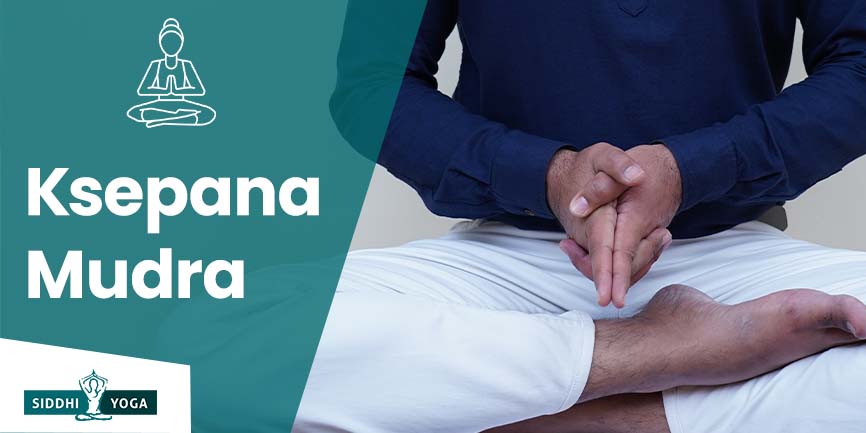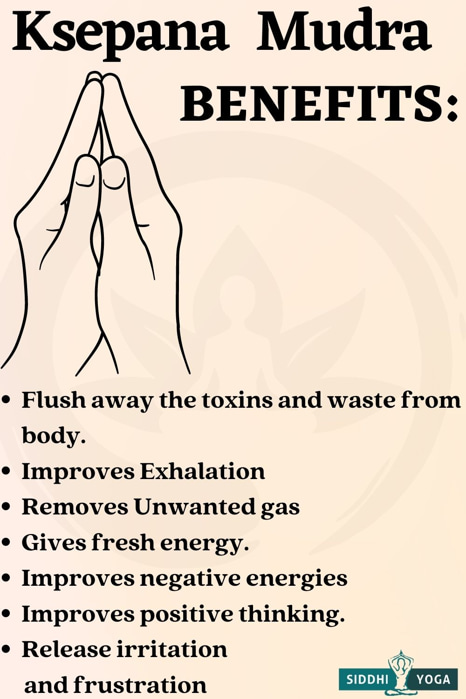
The Ksepana Mudra is one of the most beneficial yoga Mudras. Discover the meaning and benefits of the Ksepana Mudra and learn how to do it.
Definition – What is Ksepana Mudra and its Meaning, References, and Mythology?
Ksepana Mudra is a type of Hasta Mudras or hand gestures/seals. Ksepana Mudra is best known for its purifying properties. It helps to eliminate toxins and unwanted materials from our bodies. Its elimination properties are not limited to only that; it also helps in letting go of negative thoughts. So, you can also call it the “Mudra of Letting Go.” Let us bifurcate the term “Ksepana Mudra” to understand its meaning.
Ksepana – “Ksepana” is a Sanskrit term meaning “removing or casting off.”
Mudra – here, “Mudra” stands for “Hasta Mudras” or “hand gestures/seals.”
We as a human have to face many uncertainties in our lives. We don’t know what lies in our future. Sometimes, doing very well in our lives, we see a sudden fall in our mental health. We find ourselves surrounded by negative energies. We find ourselves negatively inclined. This Mudra helps to get rid of such negative energies and restores positivity within us. In addition, It is believed that Ksepana Mudra also helps to eliminate impurities from the intestines and tissues. So, this Mudra can also be considered one of the most suitable Mudras for detoxification. This Mudra also helps to protect us from a bad environment. So, the next time you experience negative energies surrounding you, try practicing Ksepana Mudra and get rid of them. If you practice this Mudra daily, then you will experience more positivity in your life.
Alternate Name of Ksepana Mudra
Mudra of Letting Go.
How to Do Ksepana Mudra?
- It is one of the Mudras that you can assume in different postures, such as Veer Bhardrasana (Warrior Pose), Shavasana (The Corpse Pose), and Tadasana (Palm Tree Pose) if you feel comfortable doing so.
- However, to achieve its maximum benefits, it is recommended that you practice it while sitting in any comfortable seated (meditative) posture. Try to choose postures in which you can distribute your entire body weight equally. And initially, keep your hands comfortably placed on your knees.
- Keep your neck and spine comfortably erect.
- Gently close your eyes and take a few deep breaths.
- Bring your entire awareness towards the breath. Breathe deeper and longer.
- Now, slowly and gently, bring your hands close to the heart center in Anjali Mudra (Or Namaste Mudra).
- Now, clasp all of your fingers and rest them.
- Your index fingers should remain extended while keeping a small cavity amidst.
- Now, cross your thumbs are rest them upon each other.
- Your Index fingers should be pointed downwards.
- You can practice Meditation and Pranayama while assuming this Mudra.
Ksepana Mudra Benefits

- It promotes better communication between two hemispheres of the brain: to experience this starts with sitting or standing in a posture where you can divide your entire body weight into two halves (e.g., Lotus Pose, Auspicious Pose, and Warrior Pose, etc.). Now, gently close your eyes. And bring your palms together close to the heart center (or chest center). After a while, you will observe subtle changes in calmness.
- It helps to get rid of all forms of toxins in the body, especially from the intestines and tissues.
- Ksepana Mudra practice also helps to clear out negativity from our body and mind. When practiced along with pranayama and meditation, its benefits increase multi-fold.
- Practicing this Mudra daily helps to stay positive.
- It improves awareness and promotes mindfulness.
- It eliminates stressors in our lives.
- It helps to protect us from negative energies and negative people.
Ksepana Mudra Precautions and Contraindications
Similar to all other Mudra practices, it has no side effects.
However, there are a few things to consider:
- Do not firmly press your finger against each other. They should be slightly touching each other and not put excessive pressure.
- A small cavity should remain amidst the index fingers when we join them together.
- Keep your spine comfortably erect without causing any aches and pains.
When and How long to do Ksepana Mudra?
This Mudra can be practiced in a lot of different ways, such as :
- This Mudra can be practiced, especially when negative thoughts have surrounded you.
- It can be practiced to improve the process of elimination of toxins.
- To detoxify our body.
- Apart from this, Ksepana Mudra can be practiced whenever you feel you are lacking focus and your peace of mind has been robbed.
Morning is the ideal time to do any yoga or Mudra. In the morning, at this time during the daytime, our brain is at its best. So, you are more likely to be able to concentrate easily. Therefore, you should practice this Mudra from 4 am and 6 am to get the most effective outcomes.
If you are having difficulty with this during the morning, you can do this Mudra later in the evening too.
Practicing this Mudra for a minimum of 30-40 minutes daily is recommended. Whether you wish to complete it in one stretch or two threes that last between 10 and 15 minutes, it’s up to you. Based on research, the best way to practice an exercise for at least 20 minutes is to get the best benefits of that particular Mudra.
Breathing in Ksepana Mudra
There are three types of breathing we can practice with this Mudra.
- Abdominal breathing is more suitable for this Mudra. Apart from Abdominal breathing, different Pranayamas can also be practiced.
Visualization in Ksepana Mudra
- I am amid white clouds.
- I feel that something soft is touching my skin.
- It is detoxifying me from within.
- I feel as light as a cloud.
Affirmation in Ksepana Mudra
While practicing this, Keep a positive intention. Start with:
“I am pure. No toxins can enter my body. I would not let any foreign thoughts or material diminish my peace.”
Conclusion
The Ksepana Mudra is a hand gesture that can help focus the mind and promote concentration during meditation. This Mudra is also said to help relieve tension headaches by gently massaging the pressure points in the palms of the hands. If you want to learn more about this and other Mudras, enroll in our Mudras Certification Course today. In addition to the Ksepana Mudra, you’ll also learn all 108 Mudras and their benefits to incorporate them into your practice.
Responses